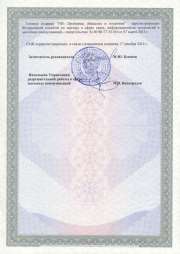|
MAIN PAGE
> Back to contents
Psychology and Psychotechnics
Reference:
Shchebetenko S., Vainshtein S.V.
// Psychology and Psychotechnics.
2014. № 1.
P. 69-82.
DOI: 10.7256/2454-0722.2014.1.9943 URL: https://en.nbpublish.com/library_read_article.php?id=9943
Большая Пятерка черт личности: эксплицитно-имплицитный подход
Shchebetenko Sergei
PhD in Psychology
associate professor, senior researcher of the Department of Developmental Psychology at Perm State University
614990, Russia, Permskii krai, g. Perm', ul. Bukireva, 15

|
shebetenko@rambler.ru
|
|
 |
Other publications by this author
|
|
|
Vainshtein Sergei Viktorovich
Perm', ul. Bukireva, 15

|
vsv-consult@hotmail.ru
|
|
 |
|
DOI: 10.7256/2454-0722.2014.1.9943
Received:
18-12-1969
Published:
1-0.461538461538-2014
References
1. Baddli A., Aizenk M., Anderson M. Pamyat'. – SPb.: Piter, 2011. 560 s.
2. Bocharov A.V., Knyazev G.G., Slobodskaya E.R., Ryabichenko T.I. Svyaz' mezhdu eks-plitsitnymi i implitsitnymi otsenkami agressivnosti: vliyanie pola, vozrasta i so-tsial'noi zhelatel'nosti // Byulleten' Sibirskogo otdeleniya RAMN. 2007. №
3. S. 41-45. 3. Burlachuk L.F., Korolev D.K. Adaptatsiya oprosnika dlya diagnostiki pyati fak-torov lichnosti // Voprosy psikhologii. 2000. № 1. S. 126-134.
4. Goldberg L.R., Shmelev A.G. Mezhkul'turnoe issledovanie leksiki lichnost-nykh chert: “Bol'shaya pyaterka” faktorov v angliiskom i russkom yazykakh // Psikhol. zhurn. 1993. T. 14. № 4. S. 32–39.
5. Efremova T.F. Bol'shoi sovremennyi tolkovyi slovar' russkogo yazyka. 2006. URL: http://dic.academic.ru/traditional_contents.php/efremova
6. Knyazev G.G., Mitrofanova L.G., Bocharov V.A. Validizatsiya russkoyazychnoi ver-sii oprosnika L. Goldberga “Markery faktorov «Bol'shoi Pyaterki»” // Psikhol. zhurn. 2010. T. 31. № 5. S. 100-110.
7. Ozhegov S.I. Tolkovyi slovar' russkogo yazyka: onlain-versiya. 2007-2010. URL: http://www.ozhegov.org
8. Osin E.N., Rasskazova E.I., Neyaskina Yu., Dorfman L.Ya., Aleksandrova L A. Operatsionalizatsiya pyatifaktornoi modeli lichnostnykh chert na rossiiskoi vyborke // Psikhol. diagnostika (v pechati).
9. Khromov A.B. Pyatifaktornyi oprosnik lichnosti: Uchebno-metodicheskoe poso-bie. Kurgan: Izd-vo Kurganskogo gos. universiteta, 2000. 23 s.
10. Shchebetenko S.A. Ustanovki na cherty lichnosti v kontekste Bol'shoi Pyaterki // Psikhologiya. Zhurnal Vysshei shkoly ekonomiki (na retsenzii).
11. Shchebetenko S.A., Vainshtein S.V. Ob izmerenii chert lichnosti posredstvom vremeni reaktsii (Chast' 1: postanovka problemy) // Vestnik Permskogo universiteta. Filosofiya. Psikhologiya. Sotsiologiya. 2010. № 3. S. 82-95.
12. Shchebetenko S.A., Vainshtein S.V. Ob izmerenii chert lichnosti posredstvom vremeni reaktsii (Chast' II: rezul'taty issledovaniya) // Vestnik Permskogo universi-teta: Filosofiya. Psikhologiya. Sotsiologiya, 2010, 4, S. 52-72.
13. Allport, G.W., & Odbert, H. S. (1936). Trait-names: A psycho-lexical study. Psy-chological Monographs, 47.
14. Anderson, R.D. (2009). The Implicit Association Test for conscientiousness: An indirect method of measuring personality. Unpublished manuscript for the degree of Master of Arts. URL: http://etd.ohiolink.edu/view.cgi/Anderson%20Ryan%20D.pdf?bgsu1237835643
15. Anderson, T.W. (1957). Maximum likelihood estimates for a multivariate normal distribution when some observations are missing. Journ. of the American Statistical Asso-ciation, 52, 200–203.
16. Arbuckle, J.L. (2012). Amos 21 Users Guide. Amos Development Corporation.
17. Asendorpf, J.B., Banse, R., & Mücke, D. (2002). Double dissociation between im-plicit and explicit personality self-concept: The case of shy behavior. Journ. of Personality and Social Psychology, 83, 380–393.
18. Back, M.D., Schmuckle, S.C., & Egloff, B. (2009). Predicting actual behavior from the explicit and implicit self-concept of personality. Journ.of Personality and Social Psy-chology, 2009, 97, 533-548.
19. Campbell D.T., & Fiske D.W. Convergent and discriminant validation by the multi-trait-multimethod matrix. Psychological Bulletin, 1959, 56, 81–105.
20. Chang, L., Connelly, B.S., & Geeza, A.A. (2012). Separating method factors and higher order traits of the Big Five: A meta-analytic multitrait-multimethod approach. Journ. of Personality and Social Psychology, 102, 408-426.
21. DeYoung, C.G., Peterson, J.B., & Higgins, D.M. (2002). Higher-order factors of the Big Five predict conformity: Are there neuroses of health? Personality and Individual Differences, 33, 533–552.
22. Egloff, B., & Schmukle, S.C. (2002). Predictive validity of an Implicit Association Test for assessing anxiety. Journ. of Personality and Social Psychology, 83, 1441–1455.
23. Goldberg, L.R. (1992). The development of markers for the Big-Five factor struc-ture. Psychological Assessment, 4, 26-42.
24. Goldberg, L.R. (2001). International Personality Items Pool, IPIP. URL: http://ipip.ori.org/
25. Greenwald, A.G., & Banaji, M.R. (1995). Implicit social cognition: Attitudes, self-esteem, and stereotypes. Psychological Review, 102, 4–27.
26. Greenwald, A.G., McGhee, D.E., & Schwartz, J.L.K. (1998). Measuring individual differences in implicit cognition: The Implicit Association Test. Journ. of Personality and Social Psychology, 74, 1464–1480.
27. Greenwald, A.G., Nosek, B.A., & Banaji, M.R. (2003). Understanding and using the Implicit Association Test: I. An improved scoring algorithm. Journ. of Personality and Social Psychology, 85, 197-216.
28. John, O.P., Donahue, E.M., & Kentle, R.L. (1991). The Big Five Inventory-Ver-sions 4a and 5. Berkeley, CA: University of California, Berkeley, Institute of Personality and Social Research.
29. John, O.P., Naumann, L.P., & Soto, C.J. (2008). Paradigm shift to the integrative Big Five trait taxonomy: History, measurement, and conceptual issues. In O.P. John, R.W. Robins, & L.A. Pervin (Eds.), Handbook of personality: Theory and research (P. 114-158). NY: Guilford Press.
30. Marsh, H.W., Lüdtke, O., Muthén, B., Asparouhov, T., Morin, A.J., Trautwein, U., & Nagengast, B. (2010). A new look at the big five factor structure through exploratory structural equation modeling. Psychological Assessment, 22, 471-491.
31. Musek, J. (2007). A general factor of personality: Evidence for the Big One in the five-factor model. Journ. of Research in Personality, 41, 1213–1233.
32. Nosek, B.A., & Smyth, F.L. (2007). A multitrait-multimethod validation of the Im-plicit Association Test: Implicit and explicit attitudes are related but distinct constructs. Ex-perimental Psychology, 54, 14-29.
33. Rushton, J.P., Bons, T.A., Ando, J., Hur, Y.-M., Irwing, P., Vernon, P.A.,... Bar-baranelli, C. (2009). A general factor of personality from multitrait–multimethod data and cross–national twins. Twin Research and Human Genetics, 12, 356–365.
34. Rushton, J.P., & Irwing, P. (2008). A general factor of personality (GFP) from two meta-analyses of the Big Five: Digman (1997) and Mount, Barrick, Scullen, and Rounds (2005). Personality and Individual Differences, 45, 679–683.
35. Schmukle, S.C., Back, M.D., & Egloff, B. (2008). Validity of the five factor model for the implicit self-concept of personality. European Journ. of Psychological Assessment, 24, 263-272.
36. Steffens, M.C., & Schulze-König, S. (2006). Predicting spontaneous Big Five be-havior with Implicit Association Tests. European Journ. of Psychological Assessment, 22, 13-20.
37. Tupes, E.C., & Christal, R.E. (1992). Recurrent personality factors based on trait ratings. Journ. of Personality, 60, 225–251.
Link to this article
You can simply select and copy link from below text field.
|
|








